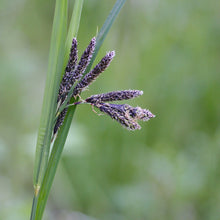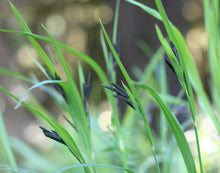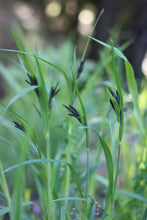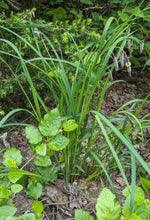
Carex mertensii
Mertens' sedge is a raingarden-worthy beauty that grows in tall, upright clumps of grass-like foliage. It’s easily distinguished from other sedges and grasses by its thick, dark inflorescences that achieve an almost purplish-hue, dangling from long peduncles each spring. In the wild, you’d find it growing in moist and wet mountain forests, roadside ditches and meadows, reaching heights up to four feet. Sedges in general are extremely valuable to wildlife (detail in bullets below) and tend to be important early sources of food, since they bloom in spring before most native grasses.
- Plant type/canopy layer: evergreen, perennial, grass or grass-like plant
- Size at maturity: 2’-4’ tall; 1’-2’ wide
- Light requirements: full sun, part sun/part shade
- Moisture requirements: moist to wet, prefers well-drained
- Bloom time: April - May
- Growth rate/ease: slow growing; easy to grow
- Wildlife support: seeds are highly sought after by small mammals and birds such as ducks, grouse, wild turkeys, sandpipers, and sparrows - especially during fall migration; foliage of sedges serves as valuable cover and nesting sites for birds, small mammals and amphibians - as well as countless species of arthropods such as beetles, flies, moths and grasshoppers; wood ducks are known to nest in the trees above sedges, so that the tufts of foliage soften the fall of fledglings as they learn to fly; the overall plant is likely a caterpillar host and larval food source for Common Ringlet and the Dun Skipper butterflies.
- Native habitat/range: common on roadsides and other disturbed sites in mesic to open forests, pumice plains, streambanks, and meadows from 50-2200 meters, across much of the western United States from Alaska to California to Montana. Though not historically present in the Willamette Valley, there are countless populations nearby in the Coast and Cascade ranges. Portland Plant List - no.
- Special features & uses: deer resistant; landscape uses include raingardens, bioswales and erosion control in wet areas.
Gardening with Mertens' Sedge: In the visual landscape, this plant's most interesting characteristic is its spring inflorescence - but from a habitat perspective, it's a year-round powerhouse. It prefers a site that gets partial to full sun with sandy or loamy soils that stay relatively moist or wet throughout the year. Please, no clay soils for this plant! The foliage is less-imposing than other sedges, making it a good one to interplant in drifts throughout moist forest opening, raingardens, bioswales or bogs, along with herbaceous plants such as lupines, sneezeweed, camas or rushes and shrubs like red twig dogwood, black twinberry and/or swamp rose. In drier areas, be sure to provide supplemental moisture in the summer months.
Photo Credits 1-3 (inflorescence, populations): Karli Del Biondo, Beetles and Bees
Photo Credit 4 (in the wild): "Carex mertensii" by Ben Keen is marked with CC0 1.0.







